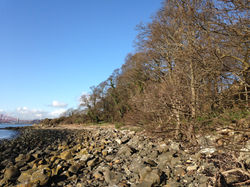Helping Tree Sparrow recovery
Most people are familiar with the cheerful and chirpy House Sparrow and you can see and hear a bunch of them that roost in the Hawthorn bush behind the Friendship Board at the Heritage Viewpoint. The related Tree Sparrow is much less familiar and is a species that suffered a major decline in the UK with the population falling by 93% between the 1970s and 1990s, causing it to become a Red listed species of conservation concern in the UK. There has been some evidence of a slow recovery since the 1990s, but the overall population is still estimated as only around 3% of its historical size before the crash. It was therefore good to see, in 2018, that a pair were exploring one of the nest boxes that we had put up in Bathing House Wood but there was no evidence that year that this was followed up by nesting and rearing young.
Tree sparrows can be distinguished from House Sparrows by their chestnut brown head and two black spots on their cheeks. Both sexes look similar.

That they were still around in 2019 was confirmed when three or four of them became regular visitors to my garden beside Hopeward Wood. Two nest boxes, attached to different walls of the house, were explored by Tree Sparrows in February, and by early March nest material, (long strands of dead grass), was being taken into both boxes, much to the annoyance of two Blue Tit pairs that had also had designs on nesting in the boxes. They didn’t have much chance against the larger Tree Sparrows and eventually gave up the contest, though not before one Blue Tit was seen dead inside one of the boxes, perhaps the victim of a tussle for possession?
By early April most of the attention was directed at the other box, with a pair of birds very busy carrying in nest material. This box had a camera and the early nest building was very clear to see, but they then covered the nest cup with a dome of dead grass, completely blocking the camera so it was not possible to see whether or not eggs had subsequently been laid. However, by early May both adults could be seen bringing food to the box. Like House Sparrows, the adults are seed eaters, but it was insect food that was being brought for the nestlings.
Blue Tits also feed their young on insect food, but their speciality is finding well camouflaged moth caterpillars hiding among the leaves and thin branches of trees such as Oak, Silver Birch and Wych Elm.

The Tree Sparrows in contrast were finding different insect prey and bringing what look like larger numbers of small adult insects, as can be seen from the wings and legs sticking out of the beak full in this photo of an adult waiting to return to the nest.

They were occasionally seen bringing "caterpillars" but this one has not been collected from among green leaves but from the ground and it may well be a beetle larva.

As the time for the young to leave the nest approached, the adults were feeding the young at the nest hole and only going in to take out one of the youngsters “poo” which the chick presents for the adult to collect and take away just after feeding. It comes out wrapped in a membrane which means the adult can take it in its beak and carry it away to drop away somewhere from the nest area. This avoids tell-tale signs of accumulating droppings alerting predators such as Magpies to the presence of potential meals of nestlings.

Eventually on 28th May two youngsters were seen flying unsteadily around near the nest with a third still being fed in the box. So this first brood appeared to have produced 3 youngsters.
Unlike Blue Tits which can raise a single brood of over 10 chicks, with laying timed to coincide with the spring emergence of moth caterpillars, Tree Sparrows lay less eggs, up to 5 or 6, but then have more broods over the summer. So it was no great surprise to find the adults bringing nesting material into the nest again in early June, and then insects to feed youngsters by the middle of that month. This time it appeared that only 1 youngster had developed to being fed at the nest hole and this one left the box on the 28th June.
As the young approach the time to leave the nest they are tempted to emerge by food being held away from them

A further brood was raised in July, this time with 3 being fed at the nest hole by the end of the month, and they were last seen at the box on 3rd August. So overall it appears that this pair of Tree Sparrows may have raised 7 chicks to the stage of fully fledged juveniles and certainly, several groups of 5 or 6 Tree Sparrows were seen around the garden over the summer.
This saga confirms that they were able to find enough suitable insect food in our woodlands to raise their chicks, and it is gratifying to think that the diversity of insects in the woods in our care have played a small part in helping the recovery of a species that has suffered so badly in recent years. It will be interesting to see if they nest again this year, either in the boxes on the house or in some of the boxes spread through all three woodlands.







































